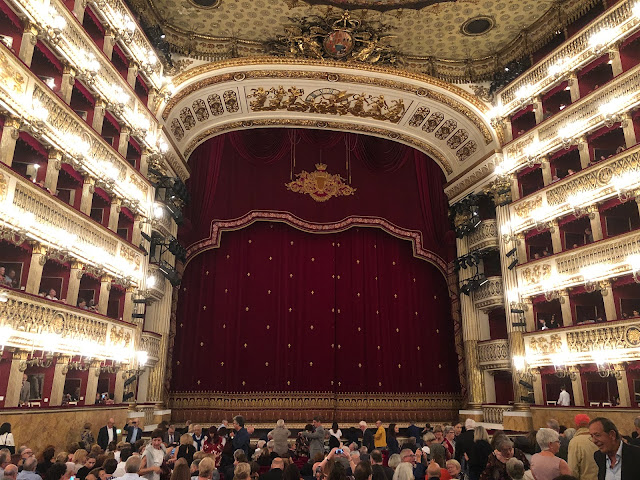【ナポリ】サン・カルロ劇場の栄光 Napoli - Glory of the San Carlo Theater
サン・カルロ劇場は、1737年の聖カルロの日、11月7日に柿落としされた。
設計したのは、アントニオ・カヴァネーリとジョバンニ・アントニオ・メドラーノという二人の建築家だった。
建築を命じたのは、当時のナポリ王カルロス7世にしてシチリア王としてカルロス5世という人物だった。
彼は、その後、スペイン王となり、スペイン王ではカルロ3世となった。それぞれの王国に代々の王がいるので、同じ人物だが、7世、5世、3世と実にややこしい。
ナポリはそれまではオーストリア・ハプスブルグ家の支配下にあったが、ポーランド継承戦争でフランス・ブルボン家のルイ15世の支援を受けて、スペイン・ブルボン家がナポリとシチリアを占領し、カルロがナポリ王およびシチリア王となった。
カルロは、祖父にあたるルイ14世を深く敬愛しており、ルイ14世がパリをヨーロッパ有数の都市に作り替えたように、ナポリを自らの力で大改造しようとした。
その一つの成果が、このサン・カルロ劇場であり、劇場の名前の聖カルロは、勿論、カルロのことでもある。
The Teatro San Carlo was demolished on November 7, 1737, St. Carl's Day.
It was designed by two architects: Antonio Cavanelli and Giovanni Antonio Medrano.
The person who ordered its construction was Charles VII, King of Naples at the time, and Charles V, King of Sicily.
He later became King of Spain, becoming Charles III of Spain. Each kingdom has successive generations of kings, so although they are all the same person, the 7th, 5th, and 3rd kings are quite confusing.
Until then, Naples had been under the rule of the Austrian Habsburgs, but during the War of the Polish Succession, the Spanish Bourbons, with the support of Louis XV of the French Bourbons, occupied Naples and Sicily, and Carlo He became King and King of Sicily.
Carlo deeply admired his grandfather, Louis XIV, and tried to transform Naples into one of the greatest cities in Europe, just as Louis XIV transformed Paris into one of the greatest cities in Europe.
One of the results of this effort is the Teatro San Carlo, and the name of the theater, San Carlo, is, of course, also a reference to Carlo.
当時のヨーロッパにおいて、これほど巨大なオペラハウスはなかった。サン・カルロ劇場は、その後しばらくは、ヨーロッパ最大のオペラハウスの名を欲しいままにした。
それ以前から、ナポリには4つの有名な音楽学校があり、そこから多くの作曲家が育ってヨーロッパ中で活躍して、彼らはナポリ楽派と呼ばれた。
その中には、オペラ創世期のスカルラッティを始め、ペルゴレージ、ヨンメッリ、パイジェッロなどの作曲家がいる。
At that time, there was no such huge opera house in Europe. The Teatro San Carlo, for a while after that, had the name of Europe's largest opera house.
Even before that, there were four famous music schools in Naples, from which many composers went on to become active throughout Europe and were known as the Neapolitan School.
Among them are composers such as Scarlatti, who was in the early days of opera, Pergolesi, Jommelli, and Paigello.
ナポリのそうした音楽学校は、元は教会が作った慈善院で、貧しい子供達を保護する施設だった。
そうした子供達の中からは、いわゆるベル・カントの美声を持つ、カストラートも生まれた。
その中には、映画の主人公にもなった、ファリネッリなどもいた。ファリネッリについては、この後、改めて触れることになるだろう。
The music school in Naples was originally a charity institute established by the church, which sheltered poor children.
Among these children, castratos with so-called beautiful bel canto voices were born.
Among them was Farinelli, who also became the main character in the movie. I'll probably touch on Farinelli again later.






コメント
コメントを投稿